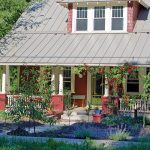
A long and vibrant life, and memories
of a beloved white peony
By Ross Howell Jr.
Amy Forbis sits in an overstuffed chair by a window that looks out on her backyard garden. The garden is shaded by old pecan and linden trees. Just outside the window is a bird feeder. A cardinal snatches a sunflower seed and flutters away. A smile crosses Amy’s lips as she watches.
This year in May Amy celebrated her 91st birthday. Twice she’s been widowed. She’s raised five children — well, seven, if you count her second husband’s two daughters. And once — in 1973 — she was shot in the stomach during an attempted carjacking.
“I wasn’t about to give that man my car keys,” Amy states, matter-of-factly, the way she discusses most topics. “It was a brand new Cutlass. And besides, I had a load of groceries in the trunk.”
The incident happened right in front of the police station in downtown Greensboro.
“So thank goodness, help was right there,” Amy says. “And you just wouldn’t believe all the people who came to the hospital to visit me.”
As we chat, Amy admits to feeling a little weak from the open-heart surgery she had a few months ago.
“Don’t pay any attention to what they tell you about your golden years,” she says. “It isn’t fun. Anytime I go anywhere now, I have my walker.”
The shelves behind her chair are filled with books. There are photographs in frames on the shelves, on the walls, on a table by the back door.
Amy first came to this house on Olive Street in 1933 when she was a girl of 8. We’re neighbors, so I’ve visited a few times. Today I’m here because she wants to tell me about a special peony in her garden. But she warms to one of her favorite topics — family.
“My father was from Henry County, Virginia, and his family owned property from an original land grant,” Amy says. Though she was born in Greensboro and has lived here nearly all her life, she says because of her father she has a special love for Virginia.
“I was a Daddy’s girl, you see,” she says.
“But Daddy didn’t want to farm, so he gave up his inheritance to follow a career in business,” she says. “He came to Greensboro and at the time was the youngest auditor in the city’s history. Daddy was working for a bank when the Depression hit, and he lost just about everything, as many people did.”
Amy’s father died when she was just 10 years old. It was a difficult time for her family.
She married her first husband, Walter Hitchcock, in 1947. He hailed from the borough of Norristown, Pennsylvania, where he had served as mayor. Hitchcock was the father of her children — Walter, Weldon (nicknamed “Sparky”), Sandra Morris (nicknamed “Morrie”), John, and Robert Lee. Hitchcock worked as an engineer with the highway department and helped build many of the main bridges for North Carolina roads. Which brings us to the peony.
As much as Amy enjoys gardening, she says it was her husband who was the real green thumb in the family.
“Anything Walt touched would turn green,” she says. “He just had that gift.”
One spring her husband was helping build a highway through High Point.
“He told me the roadway cut right through an apartment building with a big garden,” Amy says. “So he brought a peony home from that garden and planted it in the backyard, by the fence.”
She leans toward me in her chair. “You know, that was almost 70 years ago? And every year since, there’s always been at least one white peony blooming on that plant for Mother’s Day,” she says. “I can’t tell you how it makes me feel! It’s very spiritual.”
And it wasn’t just plants that Hitchcock brought home. From his highway projects he’d bring orphaned squirrels or baby rabbits from a nest. Amy remembers one Easter when Hitchcock bought up all the baby chicks a vendor had left.
“Of course the problem with chicks,” Amy says, “is they become chickens. They were all the time flying over the fence and pecking away at the plants in the garden. Oh, there was never a dull moment with Walt around, I can tell you.”
Hitchcock passed away in 1971. He had served as a U.S. Marine in the island-hopping campaigns in the Pacific Theater of World War II. Though he had survived three island invasions, the experience had taken a toll.
Amy married her second husband in 1977. Charles Forbis was of Scots-Irish descent. His family had been stout Presbyterians in the Carolinas since before the American Revolution. An ancestor, Colonel Arthur Forbis, suffered a leg wound at the Battle of Guilford Courthouse. When the leg showed signs of blood poisoning, a physician recommended amputation.
“Now the Forbises are stubborn people,” Amy says. “So the Colonel told the doctor if he was going to die, he was going to die in one piece. And that’s what he did, a few days later — gangrene. The local chapter of the North Carolina Society Daughters of the American Revolution is named in his honor.”
With Charles Forbis’s two daughters and Amy’s five children, they had quite a full house. Although they bought a home on Cridland Street, which had more space, Amy always held onto the house on Olive Street.
She asks if I’d like to tour the garden. Though I caution against the venture, she stands and dismisses my anxiety with the wave of a hand. She shuffles to the back door as I scurry to open it. Her walker is leaning against a wall by the door. She grasps the walker firmly, using it as a cane to lower herself, step-by-step, to the landing. When she’s reached the first stone of the garden walk, I help her unfold the walker, and we begin our tour.
We pass through a low arbor.
“This always reminds me of a place I used to play when I was a girl,” she says. “O.Henry’s aunt had a school on Market Street near the Masonic Home. There was a little arbor in back, and I loved to go there.”
She frets at the weeds and vines infiltrating her beds, whacking at one with the leg of her walker.
“We have men who mow the front yard,” she says to me over her shoulder. “And that’s fine. But you just can’t trust them in a garden. I had some men in once, and they pruned a fig bush with the fruit still on the branches! Can you believe such a thing?”
The stone path is uneven, yet she moves along confidently. I’m worried about the exertion. And how on earth would I explain myself to her son John, who lives with her and provides her care, should she fall out here on the stone path?
She leads on. A few feet ahead, near the center of the garden, is a rectangular pool with concrete walls about two feet tall. The water looks dark in the shade.
“I started digging this out when I was pregnant with my daughter Morrie,” Amy says. “I wanted a place where the children could cool off.”
She leans on the walker. “Of course, my work wouldn’t do for my husband Walt, the engineer. So he took over, and built everything plumb and square.” Water splatters into the pool from a pipe.
“Children from all over the neighborhood would come,” she continues. “The pool was about four feet deep. They’d swim and splash for hours, and I’d make them sandwiches at lunchtime and sit here with them and eat. They all called me ‘Mom.’ Some of the mothers in the neighborhood weren’t so happy about that.”
Now the pool is home to about 40 plump goldfish and five or six big coy. Amy tells me she feeds them once a day. Chicken wire covers the surface of the water, put there to discourage depredations by neighborhood raccoons and cats.
“See that plant there?” Amy asks. “They say it’s ancient. I can’t recall the name.”
I do a quick Google search, and find it’s horsetail, Equisetum hyemale, a plant that has changed very little from its ancestors, whose fossils trace back to 350 million years ago.
“And day lilies,” she says. “I’ve always loved them. They used to be just thick.” The yellow blossoms nod in the breeze. Ivy has spread through the bed and climbs the limbs of old azaleas. We keep moving along the path.
There are Lenten roses, and lush Southern wood ferns. Here and there, a gardenia.
Amy raises the walker and turns to me.
“You’d never know it now,” she says, “but I used to spend hours working out here. Almost every plant we had was given to us by somebody. And you know gardeners. If I ever had extra plants, I’d pass them along to somebody who wanted them.”
In addition to raising her own kids, Amy worked for 19 years at a children’s day care school run by Amelia Hopkins from her home near First Presbyterian Church. Every day Amy would come home to have lunch in her garden.
“Walt had built a table right by the pool,” she says. “First we had a sand pile the kids loved to play in. But they were always jumping from the sand pile into the pool, and Walt was worried the sand would ruin the filter and pump.” So he hauled away the sand and built a table and bench.
“It was so peaceful,” she says. “Listening to the water. And the birds. I had a lot more blooming plants then. Lots of color. My mother always called them ‘beauty plants.’ I loved them because they attracted butterflies.”
Amy turns and leads me to the spot by the fence where her husband planted the peony for her so long ago. Its foliage is deep green, shiny, vigorous.
“It bloomed this Mother’s Day,” she says. “Just like always.”
The breeze rises, whispering in the leaves of the pecan trees. A towhee calls from the azaleas at the edge of the garden.
“See that little lilac there?” Amy asks, pointing just a few feet beyond
the peony.
“My grandson planted it for my birthday,” she says. “Morrie’s boy.” Her
face is beaming.
“Isn’t it wonderful?” she asks.
I nod in agreement. Her breathing sounds labored to me, and now I’m really nervous.
“Don’t you think we should go inside?” I ask.
“I suppose,” she says.
In truth we’re just moments from the back door, but as we make our way back — Amy a bit unsteadily — to me it seems like ages.
I help Amy fold her walker and hold the door for her as she climbs the stairs. Her breathing is steady as she eases back in her chair by the window.
“I never go into the garden unless someone is with me,” she says. “I don’t want anything to happen. My balance isn’t the best. And I don’t want to put my family through anything more.”
I nod, and thank her for showing me around. As I’m taking my leave, the thought strikes me.
On our brief walk in the garden, Amy and I had traveled a lifetime. OH
Ross Howell Jr. admits failure in his experiment planting Carolina allspice in the heat of July last summer. But a friend gave him new starts this spring, and they’re thriving. “Never thank someone for a plant,” his friend cautioned. “Because it might just die.”





